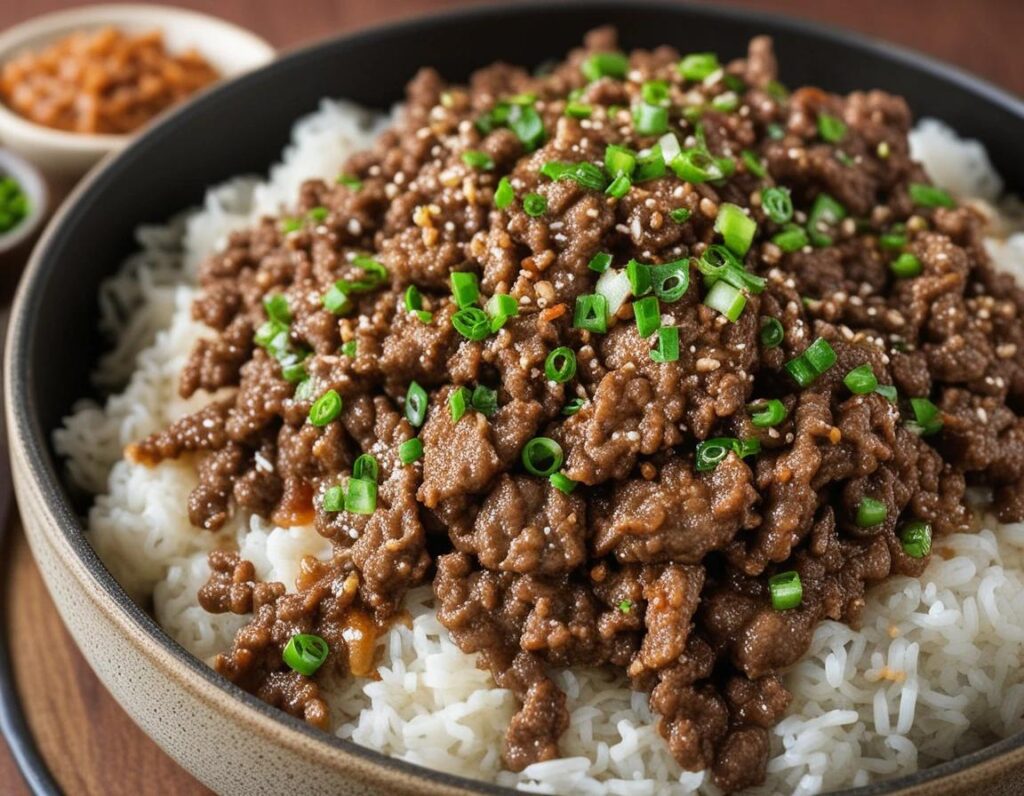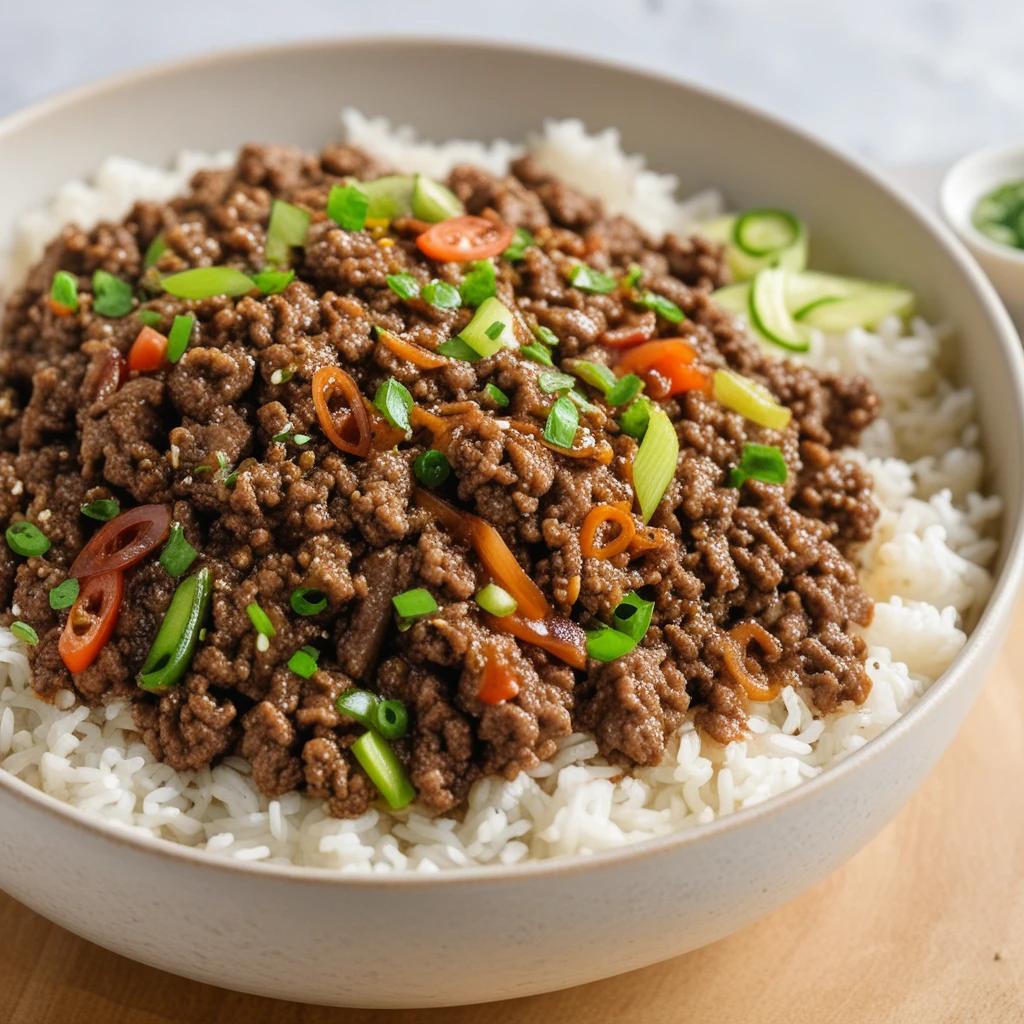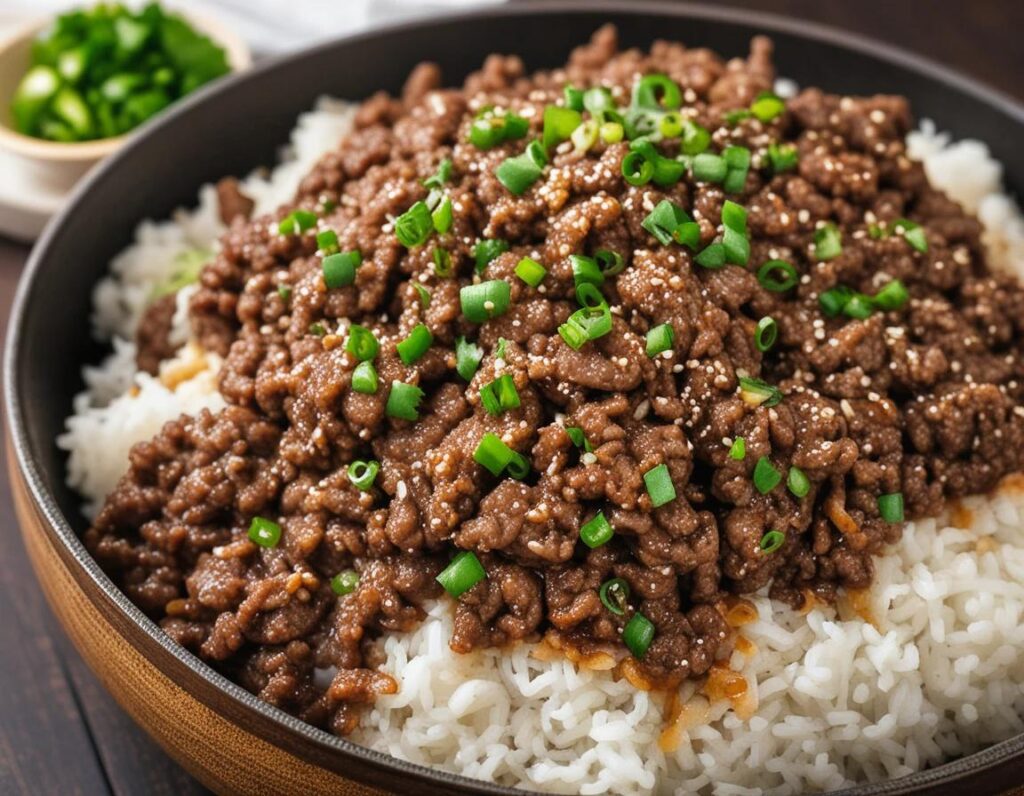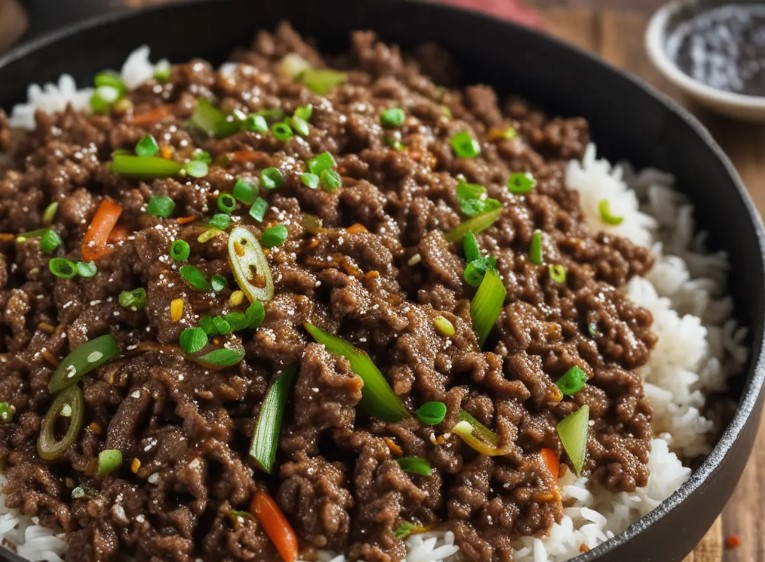Ground beef bulgogi is a delightful twist on the classic Korean bulgogi, a dish renowned for its flavorful marinated meat. While traditional bulgogi often features thinly sliced beef or pork, this version uses ground beef, making it an easier and more budget-friendly option without sacrificing the signature savory-sweet taste.
Bulgogi, meaning “fire meat” in Korean, is a dish deeply rooted in Korean culinary history, dating back to the Goguryeo era (37 BCE – 668 CE). It’s traditionally prepared with a marinade of soy sauce, sugar, sesame oil, garlic, and other ingredients, creating a harmonious balance of umami, sweetness, and nuttiness.
Ground beef bulgogi simplifies the preparation process, as it eliminates the need to slice the meat thinly. This version is perfect for busy home cooks and is incredibly versatile, pairing well with rice, noodles, lettuce wraps, or even as a topping for bowls and tacos. The dish is often garnished with sesame seeds and green onions, adding a fresh and nutty finish.
Ground beef bulgogi is an excellent introduction to Korean flavors and a wonderful example of how traditional dishes can be adapted to suit modern lifestyles while staying true to their roots. Whether you’re new to Korean cuisine or a long-time fan, this quick and delicious recipe is sure to become a household favorite.
What is Bulgogi?
Bulgogi is a traditional Korean dish that translates to “fire meat” in English, reflecting its origins as a grilled delicacy. It is one of Korea’s most iconic dishes, cherished for its rich, savory-sweet flavor and tender texture. Bulgogi is typically made from thinly sliced beef, though pork and chicken variations are also common. The dish has been enjoyed for centuries, originating during the Goguryeo period (37 BCE – 668 CE) and evolving into the beloved staple it is today.
Traditional Bulgogi: Common Ingredients
The heart of bulgogi lies in its marinade, which infuses the meat with its signature flavor profile. Common ingredients include:
- Beef: Thinly sliced cuts like sirloin, ribeye, or tenderloin are traditionally used for their tenderness and ability to absorb flavors.
- Soy Sauce: Provides a salty umami base.
- Sugar or Honey: Adds sweetness to balance the savory elements.
- Sesame Oil: Enhances the dish with a nutty aroma.
- Garlic and Ginger: Essential aromatics for depth of flavor.
- Green Onions: Contribute a mild oniony bite.
- Asian Pear (optional): Adds natural sweetness and helps tenderize the meat.
- Black Pepper: Offers a subtle spice.
Preparation Methods
- Marinating the Meat:
- The sliced meat is soaked in the marinade, typically for at least 30 minutes to several hours, allowing the flavors to deeply penetrate. For an extra tender result, the addition of grated Asian pear or kiwi is a common practice.
- Cooking Techniques:
- Grilling: Traditionally, bulgogi is grilled over an open flame or a stovetop grill, creating a smoky flavor that enhances the dish.
- Stir-Frying: In modern kitchens, it’s often stir-fried in a skillet for convenience while still achieving a delicious caramelized finish.
- Barbecue Style: Bulgogi is sometimes cooked tableside on a barbecue grill, allowing diners to enjoy freshly grilled meat.
- Serving:
- Bulgogi is often served with steamed rice and a variety of side dishes called banchan (such as kimchi, pickled radish, or sautéed vegetables).
- It can also be used in wraps with lettuce leaves, garnished with sesame seeds and green onions for a fresh touch.
Variations:
Though beef is the most traditional, pork and chicken versions of bulgogi are equally popular. These variations may include additional ingredients like chili paste (gochujang) for a spicier kick, especially in pork bulgogi.
Bulgogi’s universal appeal lies in its combination of accessible ingredients, straightforward preparation, and the complex harmony of flavors. It’s a dish that bridges the gap between tradition and modern culinary trends, making it a favorite both in Korea and around the world.
Why Use Ground Beef for Bulgogi?
Using ground beef for bulgogi is a modern twist on the traditional Korean dish, offering several practical benefits without compromising the rich flavors that make bulgogi so beloved. Here’s why ground beef is a great choice for this dish:
1. Accessibility
- Readily Available: Ground beef is widely available in most grocery stores worldwide, making it an accessible option for home cooks.
- No Special Preparation Needed: Unlike traditional bulgogi, which requires thinly slicing high-quality cuts of meat (a task that can be time-consuming and requires a sharp knife or meat slicer), ground beef is ready to use straight out of the package.
2. Cost-Effectiveness
- Budget-Friendly: Ground beef is typically more affordable than premium cuts like ribeye or sirloin, making it an economical choice for families or anyone cooking on a budget.
- Versatile Cuts: Using ground beef allows you to take advantage of less expensive cuts of meat that are ground into tender, flavorful morsels.
3. Convenience
- Quick Cooking Time: Ground beef cooks faster than thinly sliced beef, making it perfect for busy weeknight meals.
- No Marinating Required: While marinating is optional, ground beef absorbs flavors quickly due to its texture and surface area, allowing you to prepare a flavorful dish in less time.
- Ease of Use: It’s easier to handle and cook compared to thinly sliced meat, especially for beginners in the kitchen.
4. Versatility
- Multiple Serving Options: Ground beef bulgogi is adaptable and works well in various dishes, such as rice bowls, tacos, lettuce wraps, or as a topping for noodles and salads.
- Portion Control: Using ground beef allows for even distribution in dishes, making it easier to control portions and serve larger groups.
5. Enhanced Texture
- Tender and Juicy: The natural fattiness of ground beef helps maintain a juicy texture during cooking, which pairs beautifully with the savory-sweet marinade.
- Adaptable to Preferences: You can choose the lean-to-fat ratio of the ground beef to suit your taste and dietary needs.
6. Familiarity for Newcomers to Korean Cuisine
- Approachable for Beginners: For those new to Korean food, ground beef bulgogi provides a familiar base while introducing the signature flavors of bulgogi.
- Less Intimidating: It’s an easy entry point to experimenting with Korean cooking without the need for specialty cuts or advanced techniques.
In Summary:
Ground beef bulgogi is a practical, cost-effective, and convenient alternative to traditional bulgogi. It maintains the essential sweet and savory flavors of the dish while being accessible to a wider audience. Whether you’re looking for a quick and affordable meal or a way to introduce Korean cuisine to your table, ground beef bulgogi is a fantastic choice.
Key Ingredients for Ground Beef Bulgogi

Ground beef bulgogi is a flavorful and versatile dish that requires a simple yet impactful set of ingredients. Each component plays a specific role in creating the signature savory-sweet taste. Below are the essential items, possible substitutions, and the roles they play in the dish.
1. Ground Beef
- Role: The main protein, ground beef provides a tender, juicy base that absorbs the marinade flavors effectively.
- Substitutions: You can use ground pork, chicken, or turkey as leaner alternatives. Plant-based ground “meat” is an option for a vegetarian or vegan version.
2. Soy Sauce
- Role: A cornerstone of the marinade, soy sauce adds salty umami flavor and depth.
- Substitutions: Use tamari or coconut aminos for a gluten-free option. Liquid aminos can also work as a low-sodium alternative.
3. Sugar or Sweetener
- Role: Balances the saltiness and enhances the savory elements, creating the iconic sweet-savory bulgogi flavor.
- Substitutions: Honey, brown sugar, maple syrup, or stevia can be used, depending on your preference for sweetness and dietary restrictions.
4. Sesame Oil
- Role: Adds a nutty aroma and smooth richness to the dish.
- Substitutions: If unavailable, you can use neutral oils like canola or olive oil, but the nutty flavor may be missing.
5. Garlic
- Role: Provides a pungent, aromatic base that enhances the depth of flavor in the marinade.
- Substitutions: Garlic powder can be used in a pinch, though fresh garlic is preferred for its stronger flavor.
6. Ginger
- Role: Adds a warm, slightly spicy undertone that complements the sweetness and garlic.
- Substitutions: Ground ginger can be used as a substitute (1/4 teaspoon ground ginger per 1 teaspoon fresh ginger).
7. Green Onions
- Role: Adds a fresh, mild onion flavor and serves as a garnish for brightness.
- Substitutions: Chives or finely diced shallots can be used if green onions are unavailable.
8. Sesame Seeds
- Role: Used as a garnish, sesame seeds provide a crunchy texture and nutty flavor.
- Substitutions: You can omit this ingredient or use crushed peanuts or almonds for a different nutty garnish.
9. Asian Pear (Optional)
- Role: Used as a natural tenderizer and sweetener in traditional bulgogi marinades.
- Substitutions: Grated apple, kiwi, or pineapple can replicate the tenderizing and sweetening effects.
10. Black Pepper
- Role: Adds a subtle spiciness and depth to the marinade.
- Substitutions: White pepper or chili flakes can add a slightly different heat.
11. Gochujang (Optional)
- Role: A Korean chili paste, gochujang adds a mild spicy kick and extra umami.
- Substitutions: Sriracha or a combination of chili powder and a pinch of sugar can mimic the flavor.
Ingredient Roles in Harmony
The marinade’s components work together to balance saltiness, sweetness, nuttiness, and umami, creating the signature bulgogi taste. Ground beef’s texture makes it easy for these flavors to meld, ensuring every bite is flavorful.
Shopping Tip:
While most ingredients can be found in a typical grocery store, visiting an Asian market can offer authentic ingredients like gochujang and Asian pear, which enhance the dish’s traditional qualities.
With these essential ingredients and their flexible substitutions, ground beef bulgogi can be tailored to your pantry, dietary needs, and flavor preferences, ensuring a delicious result every time.
Step-by-Step Recipe: Ground Beef Bulgogi

Ingredients
- 1 lb (450 g) ground beef
- 3 tablespoons soy sauce
- 2 tablespoons sugar or honey
- 1 tablespoon sesame oil
- 3 cloves garlic, minced
- 1 teaspoon ginger, minced
- 2 green onions, finely chopped (plus extra for garnish)
- 1/4 teaspoon black pepper
- 1 tablespoon sesame seeds (for garnish)
- 1/2 small onion, finely diced (optional, for extra texture)
- 1 teaspoon gochujang (optional, for spiciness)
Optional Serving Ingredients
- Steamed white or brown rice
- Lettuce leaves (for wraps)
- Banchan (Korean side dishes like kimchi)
Preparation and Cooking Instructions
- Prepare the Marinade:
- In a bowl, mix soy sauce, sugar (or honey), sesame oil, garlic, ginger, and black pepper.
- Add gochujang if a spicy kick is desired.
- Combine with Ground Beef:
- In a large bowl, add the ground beef and pour the marinade over it.
- Mix well with your hands or a spoon until the beef is evenly coated. Let it sit for 10–15 minutes to allow the flavors to meld. (If you have time, marinate for up to 30 minutes.)
- Cook the Beef:
- Heat a non-stick skillet or wok over medium-high heat.
- Add the marinated ground beef mixture to the skillet. Break up the meat with a wooden spoon or spatula as it cooks.
- Cook for 7–10 minutes, stirring frequently, until the beef is browned and fully cooked through.
- Add Onions (Optional):
- If using finely diced onions, add them halfway through cooking. They will soften and blend into the dish.
- Finish with Garnish:
- Once the beef is cooked, sprinkle sesame seeds and green onions over the top.
- Stir gently to combine and remove from heat.
- Serve:
- Serve hot over steamed rice or in lettuce wraps. Add additional banchan as desired.
Tips for Perfect Ground Beef Bulgogi
1. Cooking Techniques
- Use Medium-High Heat: This ensures the ground beef browns and caramelizes slightly, enhancing its flavor.
- Avoid Overcrowding: Cook in batches if needed to prevent steaming the beef. Browning adds depth to the flavor.
- Break Up the Meat: Continuously stir and break the meat into small pieces for even cooking and to help it absorb the marinade fully.
2. Avoiding Common Mistakes
- Don’t Skip the Marinating Step: Even a short marination time allows the beef to absorb the flavors and prevents it from tasting bland.
- Balance the Flavors: Taste the marinade before combining it with the beef. Adjust soy sauce (for saltiness), sugar (for sweetness), or sesame oil (for nuttiness) as needed.
- Avoid Overcooking: Overcooked ground beef can become dry. Remove it from heat as soon as it’s no longer pink and is cooked through.
3. Enhancing Flavors
- Use Fresh Ingredients: Fresh garlic, ginger, and green onions significantly improve the dish’s flavor.
- Add Crunch: Serve with chopped vegetables like shredded carrots, cucumbers, or bean sprouts for extra texture and freshness.
- Double the Garnish: Sesame seeds and green onions enhance the dish’s presentation and flavor—don’t skimp on them!
- Make It Spicy: Add gochujang or red pepper flakes for heat if desired.
- Layer the Marinade: Mix in a small amount of grated Asian pear or apple for natural sweetness and tenderizing properties.
4. Serving Suggestions
- Customize Your Bowl: Serve with rice, noodles, or use it as a filling for tacos or sliders.
- Add a Fried Egg: A sunny-side-up egg on top adds richness and transforms the dish into a hearty meal.
- Pair with Banchan: Traditional Korean side dishes like kimchi, pickled radish, or spinach salad complement the flavors perfectly.
In Summary:
Perfect ground beef bulgogi is all about balancing flavors, ensuring proper cooking techniques, and getting creative with serving options. With its quick preparation and versatile nature, it’s a dish you can easily adapt to your preferences for a delicious and satisfying meal.
Variations on Ground Beef Bulgogi

Ground beef bulgogi is a versatile dish that can be adapted to suit various dietary preferences and flavor profiles. Here are some exciting variations to try:
1. Vegan/Vegetarian Bulgogi
Protein Substitute:
- Replace ground beef with plant-based ground “meat” alternatives made from soy, pea protein, or other legumes.
- Use crumbled tofu, tempeh, or finely chopped mushrooms for a more natural, whole-food option.
Marinade Adjustments:
- Use tamari, coconut aminos, or soy sauce for the umami base.
- Replace honey with a plant-based sweetener like maple syrup or agave nectar.
- Add a touch of liquid smoke to mimic the grilled flavor of traditional bulgogi.
Cooking Method:
- Cook the tofu or mushrooms over medium-high heat until browned and slightly caramelized.
- Add the marinade during the last few minutes of cooking to prevent plant-based proteins from breaking down.
2. Spicy Bulgogi
Ingredient Enhancements:
- Add gochujang (Korean chili paste) to the marinade for a spicy kick. Adjust the amount to your heat tolerance.
- Incorporate gochugaru (Korean chili flakes) for a smoky, chili-forward flavor.
- Mix in fresh red chilies or jalapeños for extra heat.
Serving Idea:
- Pair spicy bulgogi with cooling sides like cucumber salad, steamed rice, or lettuce wraps to balance the heat.
3. Fusion Adaptations For Bulgogi
Tacos:
- Use ground beef bulgogi as a filling for soft corn or flour tortillas.
- Add toppings like shredded lettuce, kimchi, pickled onions, and sriracha mayo for a Korean-Mexican fusion dish.
Rice Bowls:
- Build a bowl with a base of steamed rice, quinoa, or cauliflower rice.
- Top with the ground beef bulgogi, sautéed vegetables (like zucchini or carrots), and a fried egg.
- Drizzle with sesame oil or gochujang for added flavor.
Burgers:
- Mix the bulgogi marinade into ground beef or plant-based burger patties.
- Grill or pan-fry and serve on a bun with lettuce, sliced cucumber, and a dollop of kimchi mayo.
Pasta:
- Toss cooked spaghetti or rice noodles with ground beef bulgogi.
- Add julienned vegetables and garnish with sesame seeds and green onions for an Asian-inspired noodle dish.
Pizza:
- Use ground beef bulgogi as a topping for pizza dough.
- Add mozzarella cheese, sliced bell peppers, and a drizzle of gochujang-infused tomato sauce for a Korean twist.
4. Gluten-Free Bulgogi
Ingredient Adjustments:
- Use tamari or coconut aminos instead of soy sauce.
- Serve over rice, gluten-free noodles, or in lettuce wraps to avoid gluten-containing starches.
5. Sweet and Tangy Bulgogi
Marinade Adjustment:
- Add pineapple juice or orange juice to the marinade for a tangy, fruity twist.
- Include grated apple or Asian pear to enhance sweetness and tenderize the beef further.
Serving Suggestion:
- Pair with a simple green salad or serve in lettuce cups for a light and refreshing meal.
6. Low-Carb/Keto Bulgogi
Ingredient Substitutions:
- Replace sugar with keto-friendly sweeteners like stevia or erythritol.
- Serve with cauliflower rice or zucchini noodles instead of traditional rice.
Cooking Tips:
- Opt for fattier ground beef (e.g., 80% lean) to ensure rich flavor and juiciness without relying on carbs.
Tips for Experimenting:
- Don’t be afraid to adjust the spice level, sweetness, or texture to suit your preferences.
- Mix and match ingredients and serving styles to create your own unique version of ground beef bulgogi.
- Remember that bulgogi’s signature sweet-savory profile can be a starting point for countless creative dishes.
These variations make ground beef bulgogi a versatile dish, perfect for exploring new flavors and catering to diverse dietary needs while maintaining its iconic Korean essence.
Making Bulgogi for Meal Prepping
Bulgogi is an excellent choice for meal prepping, thanks to its bold flavors, easy preparation, and versatility. Whether you’re cooking in bulk for the week or stocking your freezer, ground beef bulgogi adapts beautifully to meal prep routines.
1. Bulk Preparation
- Scaling Up the Recipe:
Double or triple the recipe for ground beef bulgogi to ensure you have enough for multiple meals. - Batch Cooking:
Cook the bulgogi in large batches, dividing it into portions while it’s still warm. - Make Multiple Bases:
Prepare large quantities of steamed rice, noodles, or lettuce wraps to pair with the bulgogi for quick assembly.
2. Freezing Bulgogi
- Before Cooking:
- Marinate the ground beef in a freezer-safe bag or container. Remove excess air and label the bag with the date. Freeze for up to 3 months. Thaw in the refrigerator overnight before cooking.
- After Cooking:
- Allow the cooked bulgogi to cool completely before transferring it to airtight containers. Freeze for up to 2–3 months.
- To reheat, microwave or stir-fry until hot, adding a splash of water if needed to refresh the texture.
3. Versatility in Meal Plans
- Rice Bowls:
Combine bulgogi with rice, steamed vegetables, and a fried egg for a hearty meal. - Noodle Stir-Fry:
Toss reheated bulgogi with rice noodles or spaghetti, adding sautéed vegetables and a touch of soy sauce or sesame oil. - Lettuce Wraps:
Use the bulgogi as a filling for crisp lettuce wraps, topped with kimchi or pickled vegetables. - Tacos and Burritos:
Incorporate bulgogi into tortillas with toppings like shredded cabbage, gochujang mayo, and pickled onions. - Fusion Salads:
Add bulgogi to a fresh salad with sesame dressing for a Korean-inspired dish.
Common Questions About Bulgogi
1. What Sauce Should I Use for Bulgogi?
- The marinade itself is the primary sauce, made from soy sauce, sesame oil, sugar, garlic, and ginger.
- For additional sauce options:
- Gochujang Sauce: Add spiciness and umami.
- Soy-Sesame Glaze: Thicken the marinade by reducing it on the stove to drizzle over the finished dish.
2. How Many People Does One Recipe Serve?
- A standard recipe using 1 pound of ground beef typically serves 4 people when paired with rice and side dishes. Adjust portions depending on how the bulgogi is served (e.g., standalone vs. as part of a bowl or wrap).
3. Can I Make Bulgogi Without Soy Sauce?
- Yes! Substitute tamari or coconut aminos for a gluten-free option, or use low-sodium soy sauce for a milder flavor.
4. What Cut of Meat is Best for Traditional Bulgogi?
- For traditional bulgogi, thinly sliced beef cuts like ribeye, sirloin, or tenderloin are preferred for their tenderness and ability to absorb the marinade.
5. How Long Should I Marinate Bulgogi?
- Ground beef bulgogi requires minimal marinating, around 15–30 minutes. For traditional bulgogi, marinate the meat for at least 1–2 hours, or overnight for maximum flavor.
Spicy Thai Basil Chicken (Pad Krapow Gai)
Conclusion
Ground beef bulgogi is a flavorful, versatile dish that’s perfect for meal prepping, quick weeknight dinners, and exploring creative culinary fusions. Its rich savory-sweet flavor profile appeals to a wide range of palates, and its adaptability allows you to customize it for dietary needs and personal preferences.
Whether you’re making a traditional version or trying out fusion adaptations, bulgogi invites creativity in the kitchen. Give it a try and discover how this iconic Korean dish can become a staple in your meal rotation. Experiment, enjoy, and make it your own!
More Recipes
Related Recipes
- “Tuna Tomato Sauce Pasta Recipe“: A tomato-based recipe showcasing another way to use tomatoes.
- “Baked Chicken Fettuccine Alfredo with Broccoli“: Another comforting dish that can be complemented with tomato-based sauces.
Ingredient-Focused Content
- “Lions Mane Mushroom Recipe“: Suggest using a tomato gravy as a flavorful addition for plant-based dishes.
Cooking Techniques and Enhancements
- “Mango Habanero Salsa“: Explore complementary uses of sauces and gravies for flavor diversity.
Storage and Reuse Tips
- “Sous Vide Recipes“: Recommend tomato gravy as a sauce for sous vide-cooked meats or vegetables.
- “Ocean Spray Cranberry Sauce Recipe“: Guide readers on making and storing sauces, including tomato gravy.

